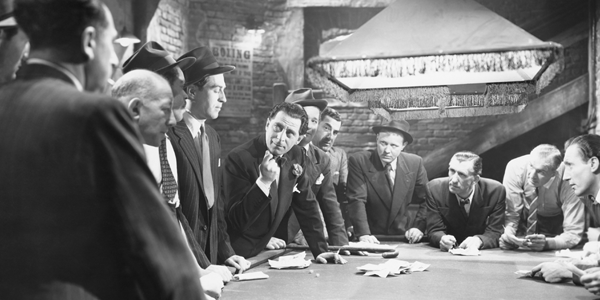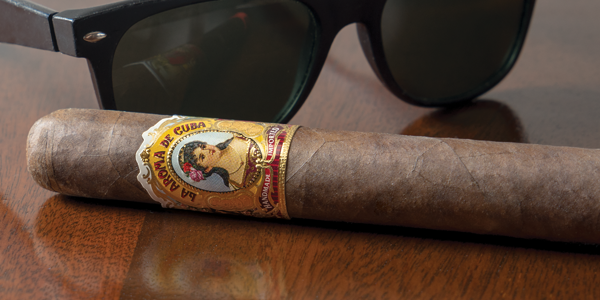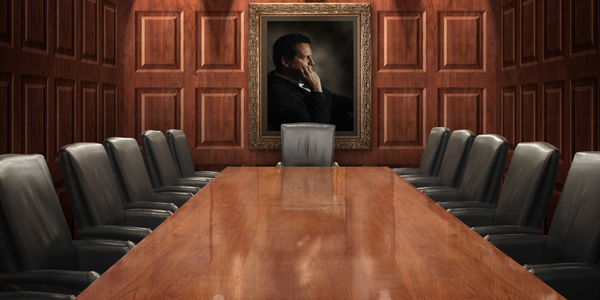History of Mafia Gangsters & Cigars
I don’t know when or exactly how this became a thing, but many movies about the Mafia seem to have the bad guys smoking cigars. Essentially, cigars were popular in mob movies because, in large measure, cigars were popular among prominent mobsters.
"The gangster has eternal appeal because of the glamour associated with the lifestyle," film historian Jeanine Basinger, former chair of the film department at Wesleyan University, explained. "It's the hat, gloves, suit and the camel coat, the fancy cars. He goes to nightclubs with beautiful women and smokes fine cigars."
Actually, the movie doesn’t even have to be about the Mafia. It just seems that, in movies, cigars equal bad guys. Now, in the real world, we know the opposite is usually true. There have, however, been some real, and really bad, Mafiosi who did smoke cigars. Is that where it started? Here are some of what we consider the more interesting cigar moments associated with the Mafia. Real and on the silver screen.
I Heard You Smoke Cigars
Martin Scorsese continued his association of cigars and wise guys in his most recent movie, The Irishman (2019), based on the book, I Heard You Paint Houses (2004). One of the first mobsters Robert de Niro’s character, Frank Sheeran, runs across is Philadelphia boss Angelo Bruno (played by Harvey Keitel). At one point an Italian cigar, a Toscano Originale, is in Keitel’s hand, but it’s not clear that Bruno was a big cigar smoker. Most of the cigar action is left to the actors who play Anthony “Tony Pro” Provenzano (played by Stephen Graham, who portrayed Al Capone in Boardwalk Empire) and Anthony “Fat Tony” Salerno (played by Domenick Lombardozzi).
“The actors did their homework,” Joel Weaver, the movie’s property master told Cigar Aficionado. “If you Google Fat Tony, there’s a big, juicy cigar in his mouth in most of the photos. So the person who smoked the most in the film was Domenick Lombardozzi. Domenick wanted a cigar for every scene. A lot of times it was not even lit.”
Chewing the Scenery & Cigar: Goodfellas
Another Scorsese movie. In what’s maybe the best cigar scene in one of the best Mafia, er, organized crime movies, Goodfellas (1990), Paulie (Paul Sorvino) is, as they say, chewing the scenery and his huge stogie. Sonny (Tony Darrow), who feels threatened by Tommy, tries to get Paulie to help by making him a partner in the restaurant.
“What am I gonna do?” Paulie says, cigar in mouth, taking a puff. “I don’t know anything about the restaurant business. Nothing! All I know is how to sit down and order a meal.” Then he glances, incredulity on his face, over at Ray Liotta.
Sonny keeps pleading. Paulie is letting out just enough line to keep Sonny in play. In the end, Paulie says he’ll try to help and winds up with a piece of the restaurant, something you just knew he was angling for all along.
“You want me to be your partner?” Paulie finally says, cigar back in his mouth. “That’s what you’re trying to tell me, you want me to be your partner?” The hook is firmly in Sonny’s mouth. Paulie, puffing away, shakes hands with Sonny.
The cigar in Goodfellas usually in Sorvino’s hands, is an iconic pairing of mob boss with cigar. I mean, could you even make a Mafia movie anymore in which the boss didn’t smoke cigars?
“My Leel Fren:” Scarface
Sure, Al Pacino was entertaining in Scarface (1983) and he certainly had the cigar (was it a Cohiba?)
on screen with him as Tony Montana for a lot of scenes, but wasn’t everything in that movie just a little over the top? When, in the final scene, Pacino screams, “Say hello to my little friend,” in a fairly comical Cuban accent, he’s apparently referring to his machine gun/grenade launcher. But it could just as easily been an introduction to his cigar.
Al Capone: The Real Scarface
Al Capone, everyone’s consensus pick for public enemy number one and the real Scarface, was a notorious cigar smoker. Capone was the boss of the most powerful mob in Chicago in the 1920s. Capone controlled alcohol, prostitution, gambling, and bootlegging. And when he was finally nabbed and found guilty for tax evasion, Capone bids farewell to his freedom by lighting up a cigar on the train that took him to the federal penitentiary in Atlanta in 1932.
Carmine Galante: “The Cigar”
In the 1930s, as a boss inside New York’s Bonnano crime family Carmine Galante was nicknamed “Cigar.” Galante helped run New York’s organized crime from the 1930s to the 1970s, interrupted by several stints in prison. He was rarely without a smoke. Galante became the biggest drug lord in New York and that made him a target. Galante was killed by the competing Gambino family after lunch on the patio at a Brooklyn Italian restaurant. The gruesome scene shows a bald, bloody Galante dead at 69, and with a cigar in his mouth.
“Sam the Cigar”
Never let it be said that the Mafia wastes a good nickname, or that it’s very creative, but Sam Giancana (born Salvatore Giangana) had several monikers, including “Sam the Cigar” for the huge Cuban cigars he liked to smoke. He was also called “’Momo,’ which he said was a contraction of what he thought about the most – more money,” wrote Fergus Mason in Sam the Cigar: A Biography of Sam Giancana (2013). Giancana, the boss of the “Chicago Outfit” Mafia gang, was constantly linked to President John F. Kennedy (with whom Giancana reportedly shared a mistress) and Frank Sinatra. Giancana allegedly had a hand in the slaying of his previous boss in an earlier crew.
Giancana’s reach extended to Louisiana where he controlled most of the illegal gambling, illegal liquor distribution, and the rackets from the early 1940s through the 1950s. He was implicated as the triggerman in three killings, but was never tried for any of them. When he was jailed in 1945, he told his children he was away at college. Perhaps “Momo’s” biggest claim to fame was that during the Kennedy administration, he was recruited by the CIA to assassinate Fidel Castro. Giancana liked to say that the CIA and the Cosa Nostra (Our Thing, as the Mafiosi referred to their organization) were “different sides of the same coin.”
In 1974, Giancana skipped to Mexico to avoid having to appear before grand juries. He was arrested there and deported to the U.S., arriving in Chicago in July. But he had fallen out of favor with the Outfit in a dispute over sharing ill-gotten gains. Giancana had police protection at his suburban Chicago home because he was scheduled to appear before a US Senate committee investigating the Mafia-CIA connection. Somehow, mysteriously, the police guards got pulled on the night of June 19, 1975. A gunman snuck in through Giancana’s basement kitchen and shot “Sam the Cigar” in the back of the head while he fried up some sausage and peppers. Not satisfied, the gunman turned Giancana over and shot him six more times.
Some blamed the CIA, but investigators surmised that the shooter was someone Giancana knew and was cooking for since Giancana had a heart condition and would not eat such rich foods.
Gotti & Son
John Gotti was widely known in New York as a mobster, but he became known to the world after ordering an unsanctioned hit (meaning the Mafia boss didn’t approve beforehand) in 1985 on Paul Castellano. The hit took place in front of Manhattan’s Sparks Steak House. Castellano had succeeded Carlo Gambino as the head of the Gambino crime family, but Castellano was widely disliked inside the family. Gotti later became the Gambino boss, known around town as “The Dapper Don” for the fine suits he wore, and also as the “Teflon Don” because no criminal charges seemed to stick. Gotti enjoyed cigars, remembers his son, John Gotti, Jr., who attended a military school.
“My father used to love to walk the grounds when he’d come to visit me,” Gotti, Jr., told Cigar Aficionado. “He’d smoke a cigar and was never followed by any FBI agents up there. I always knew my father was different.”
Junior got into the family business himself. The FBI believes that Gotti, Jr., ran the Gambinos in the 1990s while his father gave him direction from prison. Junior himself went behind bars in 1999, sentenced to 77 months, on racketeering charges. Junior was later tried four times for murder, each trial ending in a hung jury. This earned him the title of “Teflon, Jr.” Before all that, Junior enjoyed smoking in his office in Queens, until the authorities visited one day.
“The FBI, OCTF (Organized Crime Task Force), Secret Service and NYPD all raided my office,” Gotti, Jr., recalled. “All of my legitimate businesses were run out of that office. They come rushing in looking for files, going through drawers, taking pictures off the wall. I’m sitting there watching them like I don’t have a care in the world, so I decide to go into my desktop humidor and light up a cigar right in front of them. Then I go to lunch. When I came back, they took everything, including my humidor. Just to mock me, they left one cigar on my desk. I remember it was a Macanudo Vintage.”
Gotti, Jr., never got back his computers, but his humidor was returned after several months.
“The agents took some of my cigars, and the rest of them dried out,” he said.
Other Memorable Mobsters: Real & in the Movies
REAL: We seem to know Charles “Lucky” Luciano (born Salvatore Lucania) smoked cigars, or at least liked to keep some around, because his humidors were acquired and then auctioned off. Luciano holed up in Cuba, after being expelled from the US. Luciano was an associate of Benjamin “Bugsy” Siegel, a cigar smoker, and Meyer Lansky, mainly a cigarette smoker. The most famous mobsters in Cuba were lured there by the lucrative gambling and hotel operations, as well as illicit drug and prostitution rings, they could run while Fulgencio Batista was in power.
MOVIE: One of my favorite performances in a not-so-favorite movie comes from Edward G. Robinson (real name Emmanuel Goldenberg). Robinson’s character is “Johnny Rocco,” who was exiled to Cuba some years earlier. All the characters get stuck in a Key Largo hotel as a hurricane approaches. It doesn’t end well for Rocco. I mean, hell, Humphrey Bogart is the lead good guy in this film. Throughout the movie, we see Robinson using his cigar as a prop, something he did in many other pictures (check him out in The Cincinnati Kid, with Steve McQueen). Robinson also lit up in Little Caesar (1931), a film about a mobster, Caesar Enrico “Rico” Bandello,” on the rise. At the end, once more, it ends badly for the bad guy. Robinson, gunned down behind a billboard, utters, “Mother of mercy, is this the end of Rico?"
MOVIE: And I really just can’t leave out a very funny and very broad satire of the Mafia life on Long Island. In Married to the Mob (1988), Dean Stockwell plays Tony “The Tiger” DeMarco, a boss given to severely overdressing and fits of murderous jealousy. Stockwell, a real-life cigar aficionado who loved Cubans, sports a cigar in the scene of his wife’s birthday party. More delightful is when Al Lewis, the former Grandpa Munster, is puffing on a Toscano-style cigar as “Uncle Joe.”






